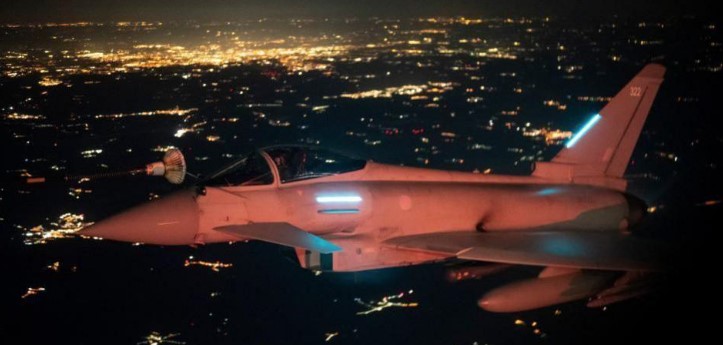On a quiet evening at RAF Brize Norton, a Voyager aircraft, ZZ-343, taxies past its more glamorous sibling, Vespina, adorned with the vibrant Union Flag. Though the two planes share the same design, their missions differ. Vespina carries royalty and VIPs during special occasions, while ZZ-343 serves the military, refueling fighter jets on critical operations.
Hybrid Warriors of the Sky with Voyager
ZZ-343 is part of Operation Eastern Sentry, a Nato-led mission supplying fuel to Typhoon jets patrolling Polish skies. The operation, unimaginable at the end of the 20th century, has become routine as Europe responds to Russian drone incursions and hybrid threats. The Voyager’s role as a flying tanker highlights Britain’s expertise in versatile military solutions, combining passenger and refueling capabilities in a single aircraft.
As the Voyager lifts into the darkening sky, it begins to carve precise ovals over the North Sea. Two Typhoon fighters emerge from the gloom, green lights blinking along their fuselages. One jet struggles against turbulence, rearing as it approaches the Voyager’s refueling pipe. Its companion lines up perfectly on the other wing, guzzling fuel before racing off to Poland as part of Nato’s coordinated response.
Did the United Kingdom Violate Its Own Arms Ban? F-35 Parts Reportedly Reached Israel
The refueling process is tense and exacting. Pilots must maintain formation within inches of error. The Voyager feeds each fighter roughly two tons of fuel mid-air, allowing them to extend their patrols far beyond home bases. Below, the North Sea glistens, dotted with orange lights marking ships thousands of feet beneath the surface. Some may belong to Russia’s shadow fleet, secretly moving fossil fuels to fund operations in eastern Ukraine.
These hybrid missions illustrate how modern warfare blends air, sea, and intelligence operations. The Voyager, though not armed, is a crucial backbone in sustaining fighter operations and ensuring Nato air superiority in contested skies.
A Testing Ground for Nato with Voyager
European nations have recently experienced repeated airspace violations. Last month, Estonian airspace was breached by three Russian fighters for twelve minutes. Poland intercepted 23 drones, some unarmed and some destroyed. Meanwhile, Danish reports highlight Russian warships tracking aircraft using sophisticated weapon systems.
These operations represent testing, warning, and pressure tactics. Nato’s response has been swift, deploying multinational air and naval assets to reassure allies and demonstrate readiness. The Voyager plays a central role, refueling fast-moving Typhoons mid-air to maintain uninterrupted patrols over vulnerable regions.
United Kingdom Unveils 100 New Sanctions to Cut Funding for Russia’s War in Ukraine
The skill required for these operations is immense. Pilots of the Voyager must navigate turbulent skies while synchronizing with fighters that accelerate and decelerate with lightning speed. One small miscalculation could result in catastrophic failure, turning a routine refueling mission into a dangerous situation. Every successful operation demonstrates coordination, precision, and technical expertise.
The Voyager fleet, along with Typhoon squadrons, forms the backbone of Nato’s aerial vigilance. Without these refueling tankers, fighter jets would have to operate closer to home, limiting the reach of patrols and weakening deterrence.
Russia’s Shadow Operations and Nato’s Vigilance
Hybrid warfare extends beyond aerial incursions. Russian shadow fleets transport fossil fuels to fund military campaigns. Drones disrupt air traffic in Denmark and Poland, while intelligence services monitor allied movements. The Voyager, delivering fuel to patrol jets, ensures Nato forces can respond promptly to these evolving threats.
Trump receives royal carriage ride and military welcome at Windsor Castle during UK state visit
Despite Russia’s smaller population and economy relative to Nato countries, hybrid tactics enable it to exert disproportionate influence. Cyber operations, airspace violations, and strategic pressure test political and military resilience. Nato’s coordinated patrols, supported by Voyager missions, demonstrate a networked defense approach, combining surveillance, air refueling, and rapid response.
As the Voyager completes its mission over the North Sea, it symbolizes the quiet but critical backbone of Nato air operations. Each flight, each refueling, and each patrol reinforces the alliance’s commitment to protecting European airspace, even as hybrid threats continue to challenge traditional boundaries.

